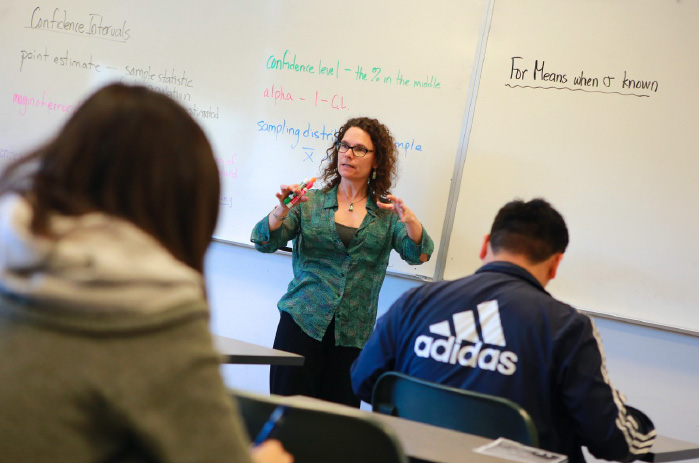‘One and Done’ Math
CSM’s math department completely revised its teaching to improve equity and success
"I like to see people have this light bulb come on. I help people spark the light bulb."
– CSM Associate Professor of Mathematics Yvette Butterworth
College mathematics can be tough. Educational inequity, poor preparation and math anxiety make it tougher. In 2018, CSM’s math faculty took the unusual step of changing their entire teaching methodology and much of their curriculum to help students succeed.
Since then – and even throughout the challenges of COVID and remote learning – CSM students receive cutting-edge strategies and support to achieve their math goals, including “co-requisite” classes that help them succeed in transfer-level work without slogging through discouraging remedial coursework.

“‘One and done math’ is the idea,” said mathematics Professor Jay Lehmann, a key member of the College of San Mateo faculty that responded to AB 705 by changing their teaching in a way they say made their department better and stronger.
“What we did, (professors) Lena Feinman and Jay Lehmann and Chris Walker, we were the leaders in coming together to initiate a new practice,” Associate Professor Yvette Butterworth said.
The changes were spurred by state Assembly Bill 705, which requires California community colleges to maximize student success in math and English by placing students in transfer-level classes within two semesters. Instead of making students take remedial classes until they either pass or give up, colleges now must offer enough targeted support that most students can enter and pass their required transfer sequences without repeating.
The issue is one of equity, because students of color are more likely to be placed in remedial classes, and students in such classes are less likely to attain their educational goals.
Key to CSM’s AB 705 response is “supported classes,” transfer-level math and statistics classes with additional co-requisite units that give teacher and students more time together. With the extra time, instructors can do more than give a lecture and assign homework. They facilitate groupwork, in which students learn more thoroughly by working together through problems they’ve seen in lecture before attempting similar homework alone. The extra class time also lets teachers explain fundamentals that students may have missed.
“I have to be flexible because I may have students in my AB 705 statistics class who don’t know PEMDAS [the order of operations used in solving equations]. I may have to talk about that before I go on. A student who’s already feeling overwhelmed is not going to research that,” Butterworth said.
Because of its proven success, CSM’s math faculty added groupwork throughout the curriculum. Butterworth was well placed to help lead this effort, having previously developed and taught groupwork-based statistics at Skyline College through a California Acceleration Project grant for Hispanic Serving Institutions. (LINK TO HSI STORY HERE) Her expertise helped CSM’s department of 12 full-time math faculty and roughly 16 adjunct instructors to transition to a more fluid groupwork strategy.
“The groupwork is really where you gain your confidence,” said alumnus Sami Shibli ’21, who credited Lehmann’s Path to Calculus course (MATH 225) with the preparation he needed to transfer in computer science to Santa Clara University.
“Talking through math is generally the best way to learn math,” Shibli said. “When you discuss, it you comprehend it.”
The change was a big one for some instructors accustomed to lecturing and then assigning problem sets, as math teachers have done for decades.
“We had a year’s worth of training, including a full weekend before fall 2018 where we simulated classrooms with the other math teachers as students,” Butterworth said.
To support each other through the change, CSM’s math faculty also began meeting regularly as a community of practice. They read books on how the brain learns math, such as Jo Boeler’s A Limitless Mind, and they share their experiences and opinions.
“They were rag sessions at first,” Butterworth said. “We would talk about the stresses and the difficulties. And maybe someone would chime in with an answer. The second semester it became a lot of us chiming in. We brought in people from other schools, and professors from other divisions, like English, which is also doing AB 705. And we urged each other, ‘Let’s make it to the finish line.’”
“As a department, we became better and closer to each other,” Feinman said.
When COVID hit, the math department quickly obtained resources including a license for GradeScope, software more common at universities that eases the strain of grading remotely submitted exam paperwork by allowing students to write and upload on tablets. CSM quickly obtained tablets to loan students as well.
Instructors doubled down on their commitment to boost students’ confidence and to reach out, often with help from CSM counselors, to students who skipped class or manifested discouragement by leaving their Zoom cameras off.
“A lot of students want to fade into the background because they’re so uncomfortable,” Butterworth said. “We say, ‘You’ve got to do this. If you step back because you’re scared of it, that’s not going to get you where you want to go.’”
Though assessment is ongoing and greatly delayed by COVID, early statewide data show that many more community college students are passing transfer-level math.

